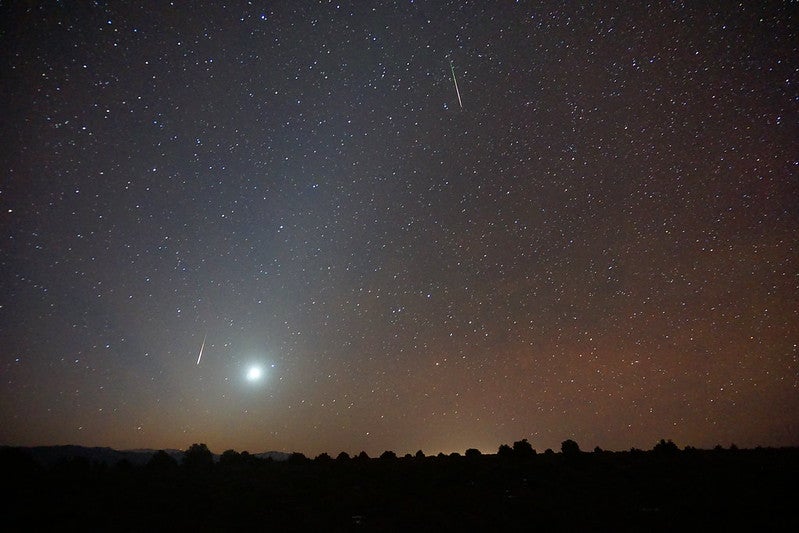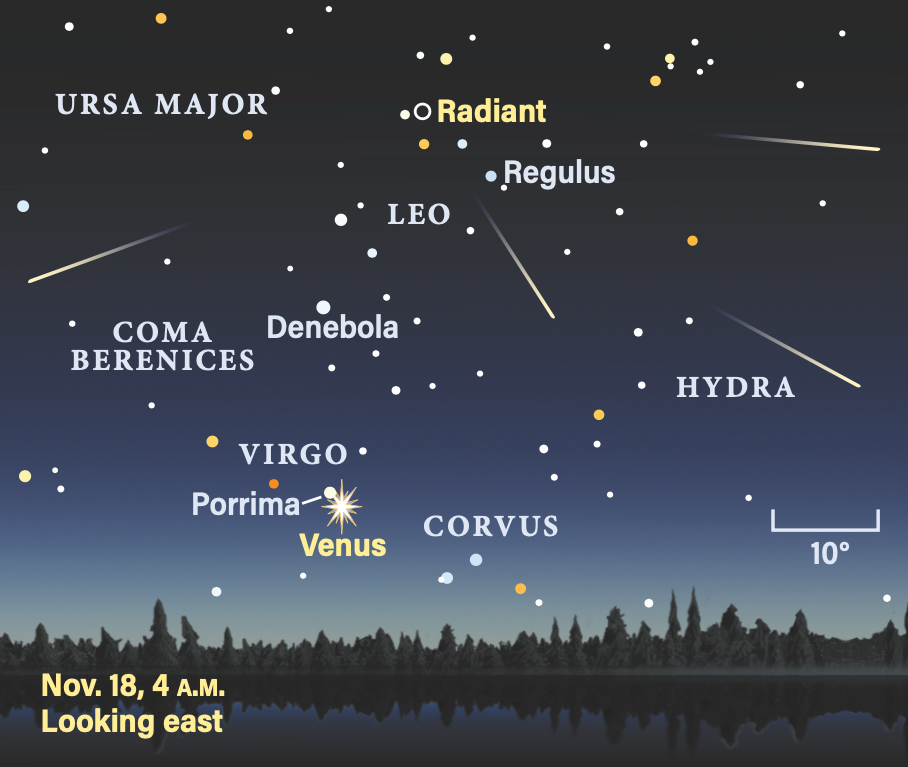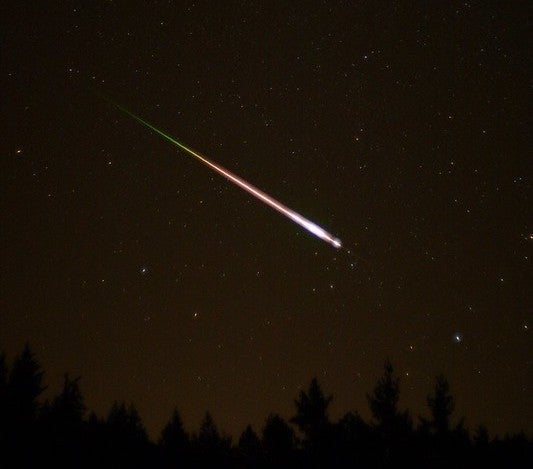
Each year, Earth experiences several meteor showers. This week, it’s time for the Leonids, which always occur in mid-November and are a longtime fall favorite. These meteors are generated from debris left by Comet 55P/Tempel-Tuttle, which rounds the Sun once every 33 years and last graced our skies in 1998.
This year’s Leonid meteor shower peaks overnight from November 17 to 18, which is ideal because it means many observers can stay up late into the early-morning hours to catch meteors without having to worry about getting up early the next day. Plus, the waxing crescent Moon sets early — around 8:30 P.M. local time on the 17th — and even while it’s up, isn’t bright enough to interfere much with the show.
When and where to look for Leonids
The very best time to see Leonid meteors will be early on the morning of the 18th, an hour or two before sunrise. That’s when Leo the Lion, which contains the radiant for the shower (and for which it is named) will be highest in the eastern sky. By an hour before local sunrise, the radiant should be some 70° overhead and meteor rates will be at their highest. Also in the morning, Earth’s leading hemisphere is turned into the shower, resulting in more impressive meteors.

Look east early on Saturday morning and the first thing you’ll likely notice is bright Venus just above the horizon, outshining any star. Venus is located in Virgo, to the lower left of Leo the Lion. So, from Venus, cast your gaze up and to the right, and look for a pattern of stars that looks like a backwards question mark, anchored by a particularly bright star at the bottom as the point. That’s the Sickle of Leo, which outlines the Lion’s head. The radiant is just to the right of the middle of the question mark’s curve. This is the point from which the Leonids appear to originate (or radiate) on the sky — but it’s also not quite where you want to look.
For the best chance of seeing bright meteors streaking past the background stars, look some 40° to 60° away from the radiant — essentially, cast your gaze all around the sky in a wide arc on either side of Leo, rather than just concentrating right on the point where the radiant lies.
Related: The Full Moon calendar for 2023 and 2024
For those who opt to look for meteors late on the 17th, wait as long as you can and again, look east as you step outside. Many Leonids appear to streak through Gemini, Orion, and even Taurus, which lie in the east above the horizon later in the evening. By about 10 P.M. local time, these constellations are roughly 30° high; they continue climbing as the night wears on. Leo itself doesn’t rise until shortly before midnight. (But again, since the best meteors streak through regions of the sky somewhat away from this constellation, it’s okay to start your search before Leo is visible!)
Below are the times for sunrise, sunset, moonrise, and moonset on Friday and Saturday — note these specific times are given in local time from 40° N 90° W:
Friday, November 17
Sunrise: 6:47 A.M.
Sunset: 4:42 P.M.
Moonrise: 11:25 A.M.
Moonset: 8:24 P.M.
Saturday, November 18
Sunrise: 6:48 A.M.
Sunset: 4:41 P.M.
Moonrise: 12:10 P.M.
Moonset: 9:39 P.M.
What the Leonids look like
The maximum number of meteors you can expect to see during the peak this weekend is about 10 per hour, with typical rates a bit lower (some few per hour). Of course, this is an average, so sometimes you might see more meteors, and sometimes less.
Although that rate may not seem high, the Leonids are still worth a look. That’s because Earth encounters the stream of particles left behind by Tempel-Tuttle nearly head-on, causing the Leonids to streak through our skies at particularly high speeds, moving faster than any other meteors. They stream through Earth’s atmosphere at speeds of nearly 44 miles (70 kilometers) per second. That means they’re more likely than slower-moving meteors to leave long, glowing trains of ionized gas in the sky. These trails of light not only follow immediately after the meteor, but some can even hang in the air for several minutes! Typical estimates reveal that roughly half of all Leonid meteors leave long trains, so even though there may not be many meteors in terms of quantity, the quality of what you’ll see more than makes up for it.

More Leonid meteors next year?
Typically right after Tempel-Tuttle passes through, within a few years Earth will experience a meteor storm with extremely high rates — some 1,000 meteors per hour or more! The last such storm occurred in 2002 and we have a while before the next bright one, which should occur shortly after the comet’s next pass in 2031. The storms are so few and far between because over time, any dense clouds of material the comet may have left behind are influenced by gravitational forces throughout the solar system, particularly Jupiter. As the giant planet tugs on the particles in the comet’s path, they move out of the way of Earth’s orbit and no longer intersect it.
Currently, some predictions show the 2024 Leonids might have an outburst of more faint meteors on offer than usual. It’s unclear whether this will actually occur, but it does make the next Leonid meteor shower pretty tantalizing. So, mark your calendar for next November — but in the meantime, don’t pass up this year’s show, as it occurs under better conditions and will surely have some memorable moments.
So, make sure you get out this Friday night or Saturday morning to enjoy the 2023 Leonids and all the bright meteors it will have to offer!









